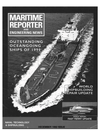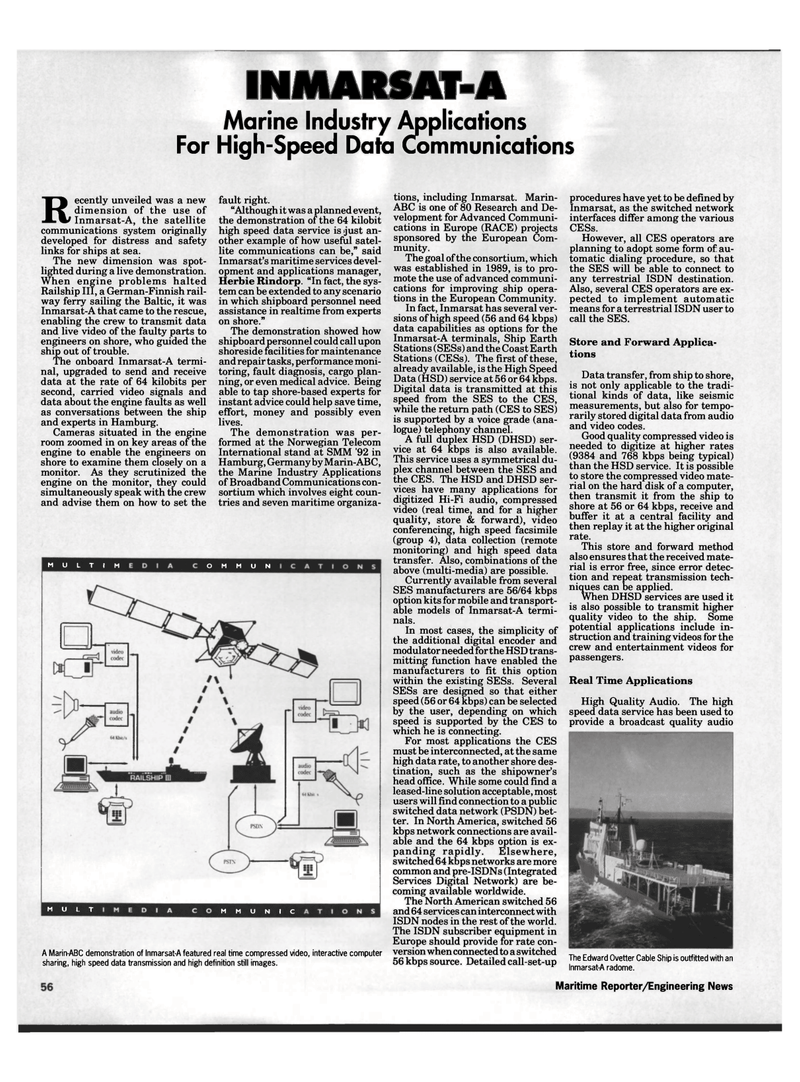
Page 56: of Maritime Reporter Magazine (December 1992)
Read this page in Pdf, Flash or Html5 edition of December 1992 Maritime Reporter Magazine
INMARSAT-A
For
Marine Industry Appli
High-Speed Data Comi ications ommunications
Recently unveiled was a new dimension of the use of Inmarsat-A, the satellite communications system originally developed for distress and safety links for ships at sea.
The new dimension was spot- lighted during a live demonstration.
When engine problems halted
Railship III, a German-Finnish rail- way ferry sailing the Baltic, it was
Inmarsat-A that came to the rescue, enabling the crew to transmit data and live video of the faulty parts to engineers on shore, who guided the ship out of trouble.
The onboard Inmarsat-A termi- nal, upgraded to send and receive data at the rate of 64 kilobits per second, carried video signals and data about the engine faults as well as conversations between the ship and experts in Hamburg.
Cameras situated in the engine room zoomed in on key areas of the engine to enable the engineers on shore to examine them closely on a monitor. As they scrutinized the engine on the monitor, they could simultaneously speak with the crew and advise them on how to set the fault right. "Although it was a planned event, the demonstration of the 64 kilobit high speed data service is just an- other example of how useful satel- lite communications can be," said
Inmarsat's maritime services devel- opment and applications manager,
Herbie Rindorp. "In fact, the sys- tem can be extended to any scenario in which shipboard personnel need assistance in realtime from experts on shore."
The demonstration showed how shipboard personnel could call upon shoreside facilities for maintenance and repair tasks, performance moni- toring, fault diagnosis, cargo plan- ning, or even medical advice. Being able to tap shore-based experts for instant advice could help save time, effort, money and possibly even lives.
The demonstration was per- formed at the Norwegian Telecom
International stand at SMM '92 in
Hamburg, Germany by Marin-ABC, the Marine Industry Applications of Broadband Communications con- sortium which involves eight coun- tries and seven maritime organiza-
M u L T I M O M M U N
MULT M M U N I C
A Marin-ABC demonstration of Inmarsat-A featured real time compressed video, interactive computer sharing, high speed data transmission and high definition still images. tions, including Inmarsat. Marin-
ABC is one of 80 Research and De- velopment for Advanced Communi- cations in Europe (RACE) projects sponsored by the European Com- munity.
The goal of the consortium, which was established in 1989, is to pro- mote the use of advanced communi- cations for improving ship opera- tions in the European Community.
In fact, Inmarsat has several ver- sions of high speed (56 and 64 kbps) data capabilities as options for the
Inmarsat-A terminals, Ship Earth
Stations (SESs) and the Coast Earth
Stations (CESs). The first of these, already available, is the High Speed
Data (HSD) service at 56 or 64 kbps.
Digital data is transmitted at this speed from the SES to the CES, while the return path (CES to SES) is supported by a voice grade (ana- logue) telephony channel.
A full duplex HSD (DHSD) ser- vice at 64 kbps is also available.
This service uses a symmetrical du- plex channel between the SES and the CES. The HSD and DHSD ser- vices have many applications for digitized Hi-Fi audio, compressed video (real time, and for a higher quality, store & forward), video conferencing, high speed facsimile (group 4), data collection (remote monitoring) and high speed data transfer. Also, combinations of the above (multi-media) are possible.
Currently available from several
SES manufacturers are 56/64 kbps option kits for mobile and transport- able models of Inmarsat-A termi- nals.
In most cases, the simplicity of the additional digital encoder and modulator needed for the HSD trans- mitting function have enabled the manufacturers to fit this option within the existing SESs. Several
SESs are designed so that either speed (56 or 64 kbps) can be selected by the user, depending on which speed is supported by the CES to which he is connecting.
For most applications the CES must be interconnected, at the same high data rate, to another shore des- tination, such as the shipowner's head office. While some could find a leased-line solution acceptable, most users will find connection to a public switched data network (PSDN) bet- ter. In North America, switched 56 kbps network connections are avail- able and the 64 kbps option is ex- panding rapidly. Elsewhere, switched 64 kbps networks are more common and pre-ISDNs (Integrated
Services Digital Network) are be- coming available worldwide.
The North American switched 56 and 64 services can interconnect with
ISDN nodes in the rest of the world.
The ISDN subscriber equipment in
Europe should provide for rate con- version when connected to a switched 56 kbps source. Detailed call-set-up procedures have yet to be defined by
Inmarsat, as the switched network interfaces differ among the various
CESs.
However, all CES operators are planning to adopt some form of au- tomatic dialing procedure, so that the SES will be able to connect to any terrestrial ISDN destination.
Also, several CES operators are ex- pected to implement automatic means for a terrestrial ISDN user to call the SES.
Store and Forward Applica- tions
Data transfer, from ship to shore, is not only applicable to the tradi- tional kinds of data, like seismic measurements, but also for tempo- rarily stored digital data from audio and video codes.
Good quality compressed video is needed to digitize at higher rates (9384 and 768 kbps being typical) than the HSD service. It is possible to store the compressed video mate- rial on the hard disk of a computer, then transmit it from the ship to shore at 56 or 64 kbps, receive and buffer it at a central facility and then replay it at the higher original rate.
This store and forward method also ensures that the received mate- rial is error free, since error detec- tion and repeat transmission tech- niques can be applied.
When DHSD services are used it is also possible to transmit higher quality video to the ship. Some potential applications include in- struction and training videos for the crew and entertainment videos for passengers.
Real Time Applications
High Quality Audio. The high speed data service has been used to provide a broadcast quality audio
The Edward Ovetter Cable Ship is outfitted with an
Inmarsat-A radome. 58 Maritime Reporter/Engineering News

 55
55

 57
57
